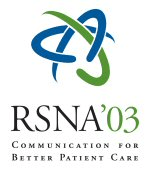
Abstract Archives of the RSNA, 2003
Edward Cho, PRESENTER: Nothing to Disclose
Abstract:Purpose/Objective: Previous studies have shown that pretreatment hemoglobin is prognostic for local control and overall survival in head and neck cancers. However, studies specific to early stage larynx cancer treated with external beam radiation therapy have shown conflicting results regarding these outcomes. The purpose of this retrospective cohort study is to elucidate a relationship between pretreatment hemoglobin levels and local control in a large cohort of patients with T1-2N0 larynx cancer treated with primary radiation therapy. Materials/Methods: Between 1975 and 2000, 258 patients (median age 62, 222 males, 36 females) with T1-2N0 squamous cell carcinoma of the glottic and supraglottic larynx were treated with primary radiation therapy at the radiation therapy facilities of the Department of Therapeutic Radiology, Yale University School of Medicine. Twelve patients were excluded from the analysis because they lacked pretreatment hemoglobin levels. The primary site was glottic in 198 patients (164 T1, 44 T2) and supraglottic in 48 patients (22 T1, 28 T2.) Patients were treated with radiation therapy using a median daily fraction of 200 cGy (range 180-255 cGy) to a total median dose of 66 Gy over 47 days. The prognostic factors studied for local control and overall survival included pretreatment hemoglobin, age, sex, race, T stage, tumor site (glottic vs. supraglottic), beam energy, biologically equivalent radiation dose, and therapy duration. Local relapse-free rate and overall survival were estimated using the Kaplan-Meier method, and multivariate analysis was done with the Cox proportional hazards model. Results: With a median follow-up of 14.4 years (range 0.05-26.1 years), 50 patients have locally relapsed with a 5-year local relapse-free rate of 77.3%. The 5-year overall survival was 69.8%. Pretreatment hemoglobin levels were assessed using the following hemoglobin quartiles (g/dL): [10.1-13.3] [13.4-14.1] [14.2-14.9] [15.0-18.3]. On univariate analysis, pretreatment hemoglobin showed significantly improved 5-year local relapse-free survival by quartiles-69.7%, 71.2%, 78.3%, 88.5% (p=0.021). Five-year overall survival also showed significant improvement by quartiles-48.6%, 67.5%, 82.5%, 78.7% (p<0.001). On multivariate analysis, pretreatment hemoglobin predicted for local failure and poorer overall survival after radiation therapy. Adjusting for other covariates (T-stage, race, biologically equivalent dose), the relative risk for 5-year local relapse by hemoglobin quartiles was 2.68 (95% confidence interval [CI] 1.07-6.69), 2.29 ([CI] 0.94-5.56), 1.94 ([CI] 0.77-4.86), 1.00 (reference quartile) (p=0.025). T stage was also significant for 5-year local relapse in the multivariate model (p=0.026). Adjusting for other covariates (T-stage, race, age, tumor site), the relative risk for poorer 5-year overall survival by hemoglobin quartiles was 2.52 ([CI] 1.29-4.95), 1.36 ([CI] 0.67-2.80), 0.84 ([CI] 0.37-1.91), 1.00 (reference quartile) (p=0.001). Additionally, age (p<0.001) and tumor site (p=0.004) were predictive for poorer 5-year overall survival in the multivariate model. Conclusions: This analysis has shown in a multivariate model that pretreatment hemoglobin levels predict local control and overall survival for early stage glottic and supraglottic cancer treated with primary radiation therapy. This relationship has potential therapeutic implications regarding correcting anemia before the initiation of radiation therapy for optimal outcome.
Cho, E,
Prognostic Value of Pretreatment Hemoglobin for Local Control and Overall Survival in T1-2N0 Larynx Cancer Treated with External Beam Radiation Therapy. Radiological Society of North America 2003 Scientific Assembly and Annual Meeting, November 30 - December 5, 2003 ,Chicago IL.
http://archive.rsna.org/2003/3239811.html

